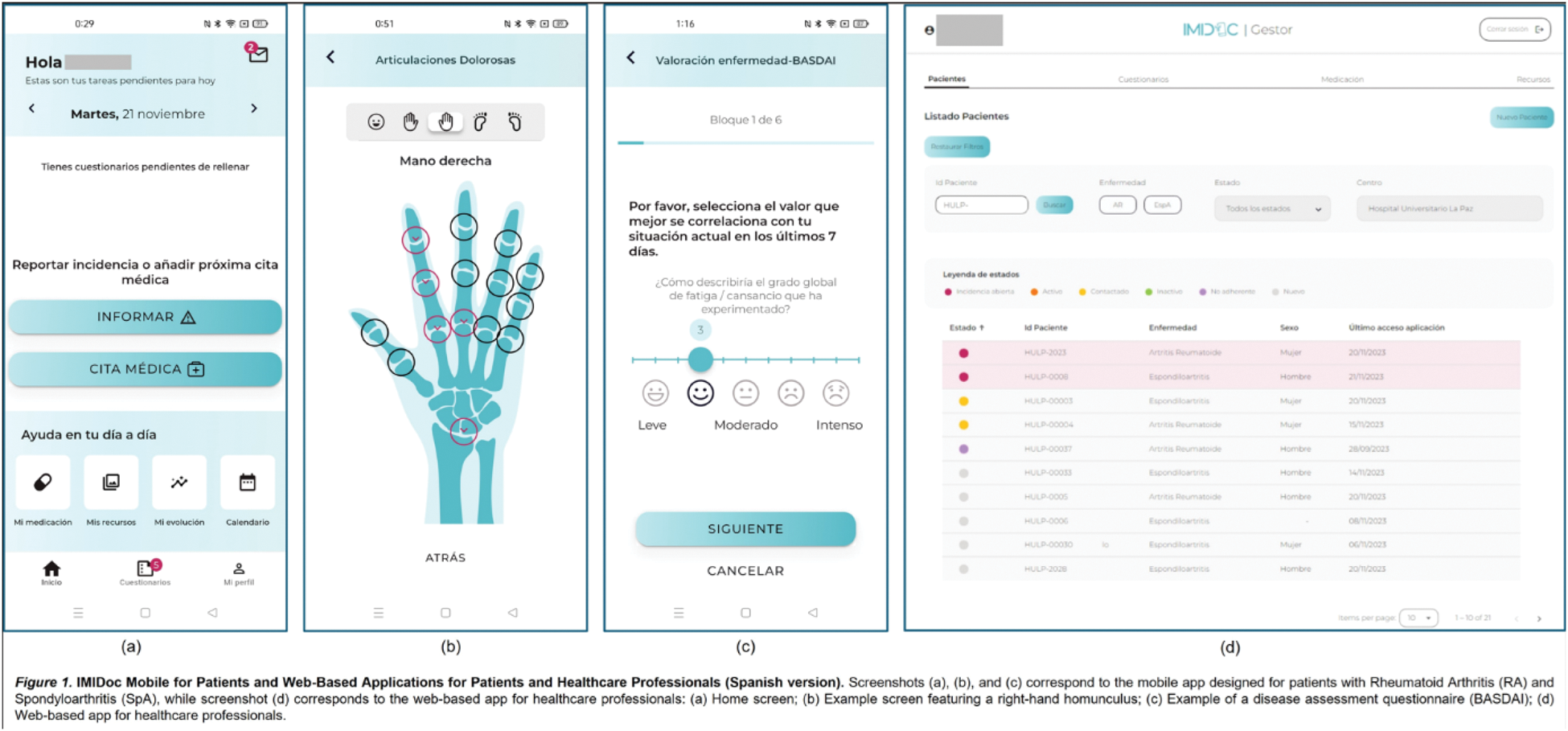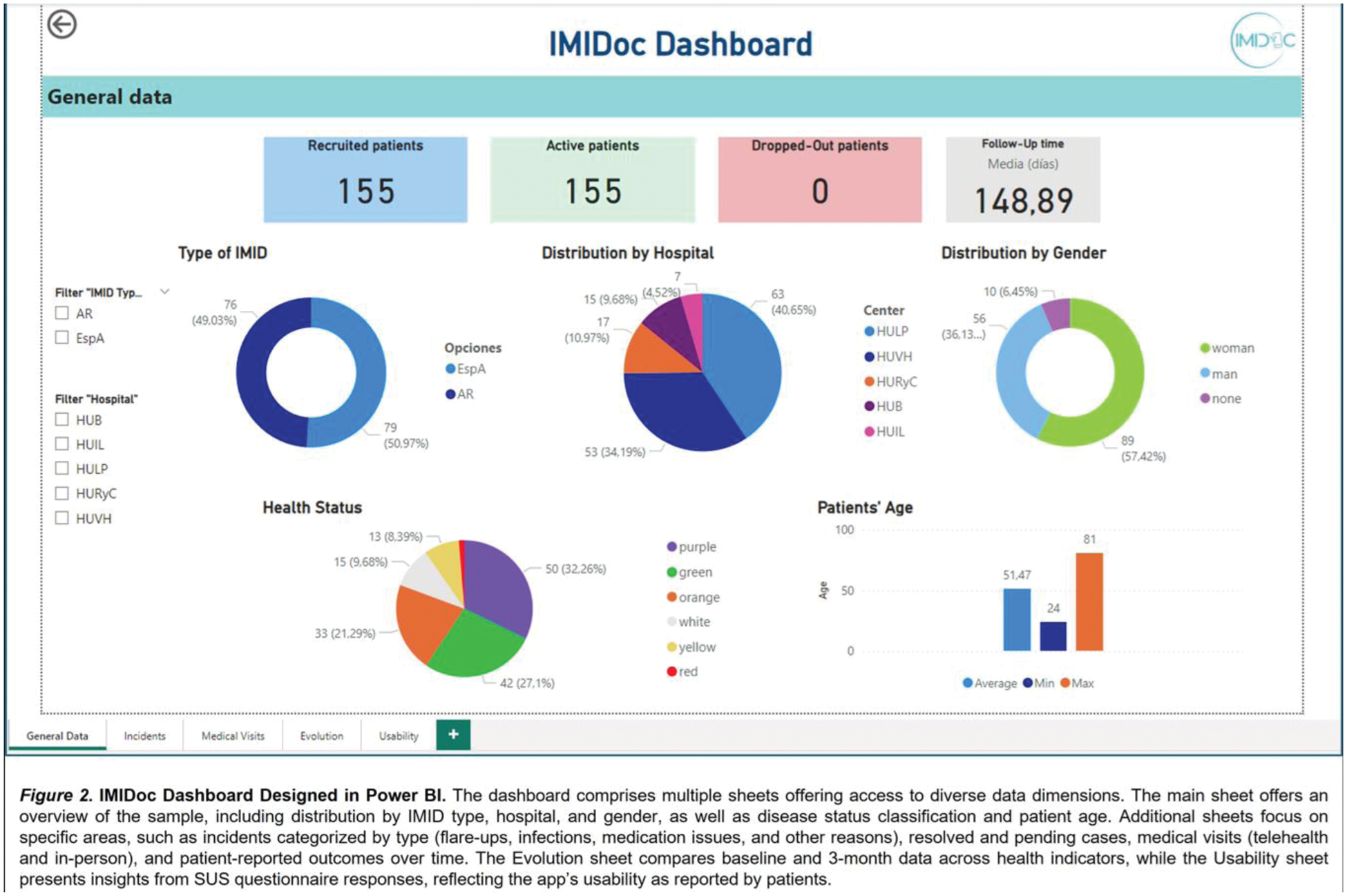

Background: Immune-mediated inflammatory diseases (IMIDs), such as rheumatoid arthritis (RA) and spondyloarthritis (SpA), cause joint and spine inflammation with episodic flares, leading to significant functional impairment. Managing these diseases is challenging due to complex therapies and the need for close monitoring and effective communication between patients and healthcare professionals. Digital health tools, including telemonitoring, offer promising solutions to address gaps in current care models by enhancing patient tracking and communication. Previous research, from our research group, demonstrated the potential of electronic patient-reported outcomes (ePROs) in reducing in-person visits, but highlighted challenges in patient adherence and app design [1]. Building on this experience, a mixed care model (MAM) was proposed, combining in-person and remote visits supported by a tailored digital solution to meet the needs of both patients and professionals [2]. Feedback from prior studies informed improvements in app design, functionality, and implementation feasibility.
Objectives: To evaluate the clinical implementation of a mixed care model (MAM) using a digital tool for patients and healthcare professionals, called IMIDOC®.
Methods: This prospective, multicenter study was conducted within the framework of the FIS PI22/00777 project. In the first phase of the project, a digital health tool named IMIDOC was developed, comprising a mobile app for patients and a web-based app for healthcare professionals. Through the IMIDOC app (Figure 1a–c), patients can report outcomes related to their health status (patient-reported outcomes, PROs) and clinical incidents to healthcare professionals, access educational resources, and schedule medical appointments and medication reminders. The professionals’ webApp (Figure 1d) allows the monitoring of patient progress and incidents to ensure timely resolution. In the second clinical phase, 260 patients with rheumatoid arthritis (RA) and spondyloarthritis (SpA) treated with biological or targeted synthetic DMARDs (b/tsDMARDs) will be recruited for protocolized mixed follow-up over a maximum period of 12 months. Additionally, to support the analysis and visualization of study data, we developed the IMIDoc Dashboard using Power BI (Figure 2).
Results: From April to October 2024, a total of 155 patients were recruited. The gender distribution was 36% male, 57% female, and 7% unspecified, with a mean age of 51.1 years (±12.1). Among the patients, 49% were diagnosed with rheumatoid arthritis (RA), while 51% presented with spondyloarthritis (SpA). The mean follow-up time for patients within the IMIDOC program was 148.9 days (± 84.7). To date, 141 incidents have been recorded, distributed as follows: 22% flares, 9% infections, 28% medication-related issues, and 41% other types. Of these incidents, 99% were resolved remotely (72% via messaging, 26% via phone calls), with only 1% requiring in-person consultations. The median (IQR) resolution time was 1 (0–3) days. Regarding the 270 medical visits conducted during the study, 28% were remote and 72% were in-person. In total, patients completed 7,430 patient-reported outcomes (PROs) questionnaires (3,143 for RA and 4,277 for SpA). The most frequently completed PROs in RA were p-NAD (16%), p-NAT (15%), and p-VAS (14%), while for SpA, they were p-NAD (12%), p-painful entheses (12%), and p-VAS (11%). Based on our classification of disease activity derived from completed PROs: 35% of patients were stable with low activity, 22% were stable but active, 33% were non-adherent in completing PROs, and 10% could not be classified due to being recruited less than four weeks prior. A total of 350 consultations with educational resources were recorded, with at least 91 (59%) patients engaging with these resources. The median (IQR) number of educational resources accessed per patient was 1 (0–3). The educational resources were divided into general (11) and specific (11 for RA and 10 for SpA). Overall, the most frequently accessed resources were related to self-assessment of joint activity, the role of the rheumatologist, and recognizing early signs of rheumatologic diseases. The usability of the mobile application was rated at 83 on the System Usability Scale (SUS).
Conclusion: The MAM with the IMIDOC tool offers a promising alternative for the follow-up of these diseases, combining clinical management with digital support and improving access to information and real-time problem resolution.
REFERENCES: [1] Benavent D, Fernández-Luque L, Núñez-Benjumea FJ, Navarro-Compán V, Sanz-Jardón M, Novella-Navarro M, et al. Monitoring chronic inflammatory musculoskeletal diseases mixing virtual and face-to-face assessments-Results of the digireuma study. PLOS digital health [Internet]. 2022 Dec 7 [cited 2023 Sep 11];1(12): e0000157.
[2] Marta Novella-Navarro, Jose M Iniesta-Chamorro, Diego Benavent, Javier Bachiller-Corral et al. Toward Telemonitoring in Immune-Mediated Inflammatory Diseases: Protocol for a Mixed Attention Model Study. JMIR Res Protocol. 2024 Apr 22:13: e55829. doi: 10.2196/55829.


Acknowledgements: This work was supported by: Fondo para la Investigación Sanitaria, Instituto de Salud Carlos III (PI22/00777).
Disclosure of Interests: None declared.
© The Authors 2025. This abstract is an open access article published in Annals of Rheumatic Diseases under the CC BY-NC-ND license (